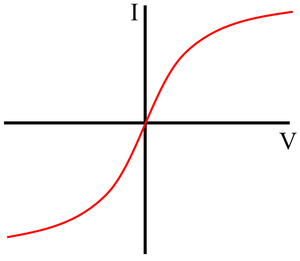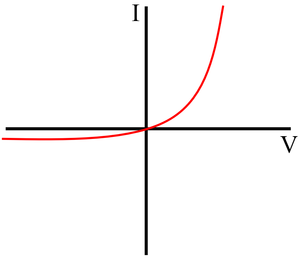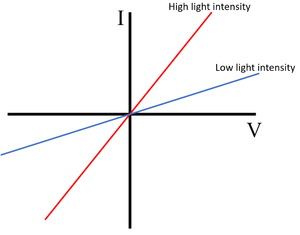Difference between revisions of "IV Graph"
(→About IV Graphs) |
|||
| (3 intermediate revisions by 2 users not shown) | |||
| Line 7: | Line 7: | ||
: An '''IV graph''' can be used to identify the characteristics of an unknown [[Electrical Component|electrical component]]. This may be useful when inventing new [[Electrical Component|components]]. | : An '''IV graph''' can be used to identify the characteristics of an unknown [[Electrical Component|electrical component]]. This may be useful when inventing new [[Electrical Component|components]]. | ||
: The [[Electrical Resistance|resistance]] of an [[Electrical Component|component]] can change with the [[Electrical Current|current]] or the [[Potential Difference|potential difference]]. | : The [[Electrical Resistance|resistance]] of an [[Electrical Component|component]] can change with the [[Electrical Current|current]] or the [[Potential Difference|potential difference]]. | ||
| − | : The [[Electrical Resistance|resistance]] of a [[Electrical Component|component]] can be found by taking the [[ratio]] of [[Potential Difference|potential difference]] to [[Electrical Current|current]] at a point on the curve. | + | : The [[Electrical Resistance|resistance]] of a [[Electrical Component|component]] can be found by taking the [[ratio]] of [[Potential Difference|potential difference]] to [[Electrical Current|current]] at a point on the curve of an '''IV graph'''. |
===Examples=== | ===Examples=== | ||
| + | {| class="wikitable" | ||
| + | |- | ||
| + | |[[File:IVGraphResistor.png|center|300px]] | ||
| + | |[[File:IVGraphBulb.png|center|300px]] | ||
| + | |- | ||
| + | | style="height:20px; width:200px; text-align:center;" |The '''IV graph''' for a [[resistor]] shows that [[Electrical Current|current]] is [[Directly Proportional|directly proportional]] to [[Potential Difference|potential difference]]. | ||
| + | | style="height:20px; width:200px; text-align:center;" |The '''IV graph''' for a [[Electrical Bulb|bulb]] shows that as the [[Potential Difference|potential difference]] increases the [[Electrical Current|current]] increases. However, at large [[Potential Difference|potential differences]] a change in [[Potential Difference|potential difference]] causes a smaller increase in [[Electrical Current|current]] for a change at small [[Potential Difference|potential differences]]. | ||
| + | |- | ||
| + | |[[File:IVGraphDiode.png|center|300px]] | ||
| + | |[[File:IVGraphLDR.png|center|300px]] | ||
| + | |- | ||
| + | | style="height:20px; width:200px; text-align:center;" |The '''IV graph''' for a [[diode]] shows that for a positive [[Potential Difference|potential difference]] the [[Electrical Current|current]] increases rapidly with an increase in [[Potential Difference|potential difference]] while for a negative [[Potential Difference|potential difference]] the [[Electrical Current|current]] remains negligible and does not increase as the [[Potential Difference|potential difference]] becomes larger. | ||
| + | | style="height:20px; width:200px; text-align:center;" |The '''IV graph''' for a [[Light Dependent Resistor|light dependent resistor]] shows that at a high [[light]] intensity the [[Electrical Current|current]] increases rapidly with the [[Potential Difference|potential difference]] whereas at a low [[light]] intensity the [[Electrical Current|current]] increases slowly with the [[Potential Difference|potential difference]]. | ||
| + | |} | ||
| + | |||
| + | ===References=== | ||
| + | ====Edexcel==== | ||
| + | |||
| + | :[https://www.amazon.co.uk/gp/product/1782945741/ref=as_li_tl?ie=UTF8&camp=1634&creative=6738&creativeASIN=1782945741&linkCode=as2&tag=nrjc-21&linkId=30da4f2178da182547b62a7329d13b57 ''I-V graphs, page 187, GCSE Combined Science; The Revision Guide, CGP, Edexcel ''] | ||
| + | :[https://www.amazon.co.uk/gp/product/1782945733/ref=as_li_tl?ie=UTF8&camp=1634&creative=6738&creativeASIN=1782945733&linkCode=as2&tag=nrjc-21&linkId=2a2dbec9db6bf5766c0458d908fa0a52 ''I-V graphs, page 74, GCSE Physics; The Revision Guide, CGP, Edexcel ''] | ||
| + | :[https://www.amazon.co.uk/gp/product/1782948163/ref=as_li_tl?ie=UTF8&camp=1634&creative=6738&creativeASIN=1782948163&linkCode=as2&tag=nrjc-21&linkId=0fdbfd5dd397d6e24a9dfb250f08587f ''I-V graphs, pages 227-229, GCSE Physics, CGP, Edexcel ''] | ||
| + | :[https://www.amazon.co.uk/gp/product/1782948163/ref=as_li_tl?ie=UTF8&camp=1634&creative=6738&creativeASIN=1782948163&linkCode=as2&tag=nrjc-21&linkId=0fdbfd5dd397d6e24a9dfb250f08587f ''I-V graphs; diodes, page 229, GCSE Physics, CGP, Edexcel ''] | ||
| + | :[https://www.amazon.co.uk/gp/product/1782948163/ref=as_li_tl?ie=UTF8&camp=1634&creative=6738&creativeASIN=1782948163&linkCode=as2&tag=nrjc-21&linkId=0fdbfd5dd397d6e24a9dfb250f08587f ''I-V graphs; filament lamps, page 228, GCSE Physics, CGP, Edexcel ''] | ||
| + | :[https://www.amazon.co.uk/gp/product/1782948163/ref=as_li_tl?ie=UTF8&camp=1634&creative=6738&creativeASIN=1782948163&linkCode=as2&tag=nrjc-21&linkId=0fdbfd5dd397d6e24a9dfb250f08587f ''I-V graphs; fixed resistors, page 228, GCSE Physics, CGP, Edexcel ''] | ||
| + | :[https://www.amazon.co.uk/gp/product/1782948163/ref=as_li_tl?ie=UTF8&camp=1634&creative=6738&creativeASIN=1782948163&linkCode=as2&tag=nrjc-21&linkId=0fdbfd5dd397d6e24a9dfb250f08587f ''I-V graphs; LDRs, page 229, GCSE Physics, CGP, Edexcel ''] | ||
| + | :[https://www.amazon.co.uk/gp/product/1782948163/ref=as_li_tl?ie=UTF8&camp=1634&creative=6738&creativeASIN=1782948163&linkCode=as2&tag=nrjc-21&linkId=0fdbfd5dd397d6e24a9dfb250f08587f ''I-V graphs; thermistors, page 229, GCSE Physics, CGP, Edexcel ''] | ||
| + | |||
| + | ====OCR==== | ||
| + | :[https://www.amazon.co.uk/gp/product/1782945687/ref=as_li_tl?ie=UTF8&camp=1634&creative=6738&creativeASIN=1782945687&linkCode=as2&tag=nrjc-21&linkId=9a598e52189317a20311d7a632747bc9 ''I-V graphs, pages 45-47, Gateway GCSE Physics; The Revision Guide, CGP, OCR ''] | ||
Latest revision as of 16:21, 13 December 2019
Contents
Key Stage 4
Meaning
An IV graph is a graph showing how the current (I) through a component changes with the potential difference (V) across component.
About IV Graphs
- On an IV graph the potential difference is plotted on the x-axis and the current is plotted on the y-axis.
- An IV graph can be used to identify the characteristics of an unknown electrical component. This may be useful when inventing new components.
- The resistance of an component can change with the current or the potential difference.
- The resistance of a component can be found by taking the ratio of potential difference to current at a point on the curve of an IV graph.
Examples
| The IV graph for a resistor shows that current is directly proportional to potential difference. | The IV graph for a bulb shows that as the potential difference increases the current increases. However, at large potential differences a change in potential difference causes a smaller increase in current for a change at small potential differences. |
| The IV graph for a diode shows that for a positive potential difference the current increases rapidly with an increase in potential difference while for a negative potential difference the current remains negligible and does not increase as the potential difference becomes larger. | The IV graph for a light dependent resistor shows that at a high light intensity the current increases rapidly with the potential difference whereas at a low light intensity the current increases slowly with the potential difference. |
References
Edexcel
- I-V graphs, page 187, GCSE Combined Science; The Revision Guide, CGP, Edexcel
- I-V graphs, page 74, GCSE Physics; The Revision Guide, CGP, Edexcel
- I-V graphs, pages 227-229, GCSE Physics, CGP, Edexcel
- I-V graphs; diodes, page 229, GCSE Physics, CGP, Edexcel
- I-V graphs; filament lamps, page 228, GCSE Physics, CGP, Edexcel
- I-V graphs; fixed resistors, page 228, GCSE Physics, CGP, Edexcel
- I-V graphs; LDRs, page 229, GCSE Physics, CGP, Edexcel
- I-V graphs; thermistors, page 229, GCSE Physics, CGP, Edexcel



